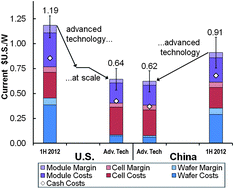While most people assume that China’s quick rise in dominance on solar manufacturing is because of really low labor costs and huge government subsidies, that turns out not to be the case.
In fact, the US still has the opportunity to lead the world, because other factors are more important in determining market share, concludes a report from National Renewable Energy Lab (NREL) and Massachusetts Institute of Technology (MIT).
The key differentiator is the scale of production, they say, not labor costs, that have catapulted China to the world’s center of low-cost solar manufacturing.
And the tool China has used to attain that scale is preferred access to capital for solar manufacturers, which benefits the entire supply chain.
This suggests that the current advantages China-based manufacturers enjoy can be reproduced in the US.
Indeed, China’s advantages in low-cost manufacturing are offset by investment risk, inflation and other factors. The US, meanwhile, has the ability to excel on technology innovation.
"Our analysis finds that investments in technology research and development are critical not only to the widespread deployment of solar PV in most locations, without subsidy, but also may equalize factors that affect regional competitiveness, thus creating opportunities for U.S.-based manufacturers," says Alan Goodrich, Senior Analyst with NREL. "The race for cost-competitive clean energy from the sun is far from over and incredible growth opportunities remain."
Innovations in crystalline silicon solar cell technology would spur new investment, which would significantly enhance access to capital for manufacturers in most regions and enable scale-up, thus equalizing PV prices from manufacturers in the US and China, researchers say.
"We believe that innovation could drive down costs and drive up efficiencies not only in PV manufacturing, but also in the production of other high-tech and high-value clean energy technologies, and position U.S.-based manufacturers to be leaders in one of the most important global economic races of the 21st century," says David Danielson, Assistant Secretary for Energy Efficiency and Renewable Energy at the Department of Energy.
Researchers calculated minimum sustainable prices (MSP) for monocrystalline silicon solar panels manufactured in the US and China, simulating how a global manufacturing firm decides where to locate its factories. MSP is the lowest price at which a company can sell its products, while providing expected returns to sources of capital – conditions that are necessary to sustain growth without subsidies.

Excluding shipping costs, the team estimates that China-based manufacturers have a 23% MSP advantage over U.S.-based manufacturers today, after controlling for differences in the cost to make solar components in each country. Scale and supply-chain advantages account for the majority of China’s lead.
Since these advantages aren’t inherent to China, they can be replicated by US-based manufacturers if comparable scale can be achieved.
How do you get the capital investment to achieve that scale in the US?
"The technology must be truly innovative, low cost, and able to compete subsidy-free. "The ‘holy grail’ is an innovative PV module with high efficiency, low material costs, streamlined and scalable manufacturing, and unquestionable reliability," explains Tonio Buonassisi, associate professor at MIT and co-author of the study.
"The PV modules you can buy today have a few of these attributes, but not all of them together. Thus, practical technological innovation is a key driver to accelerate the convergence between photovoltaics and traditional energy sources, both in terms of price and scale. This common goal, for the benefit of all nations, is an opportunity for international cooperation that leverages our complementary strengths."
Read the report, Assessing the Drivers of Regional Trends in Solar Photovoltaic Manufacturing:

 Loading...
Loading...
This is a well-done article, we need to remember that the game is still not lost. But there is another side. Manufacturing infrastructure develops its own inertia, and the longer we allow the U.S. PV industry to attempt to compete in a field of other other heavily-subsidized energy technologies without having those same benefits, the more difficult it will be for the PV to ever catch up.
Industries become established with time, and there is a reason why — for instance — so many wristwatches are made in Switzerland and so few are made in the USA.
Sure, we can catch up in PV, but it will require genuine cooperation and economic sacrifice. Never in the history of energy has there been a technology that has the potential to produce energy at as low of a thermodynamic and maintenance cost as solar PV. The reality is coming, we just need to decide if we are going to be producers or just consumers of that future.